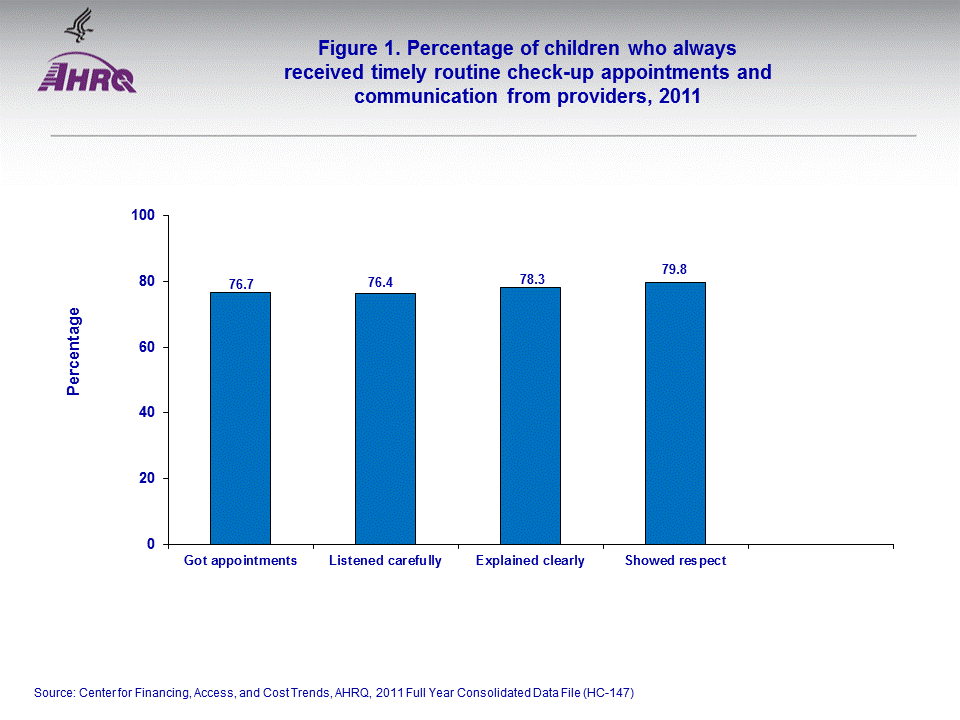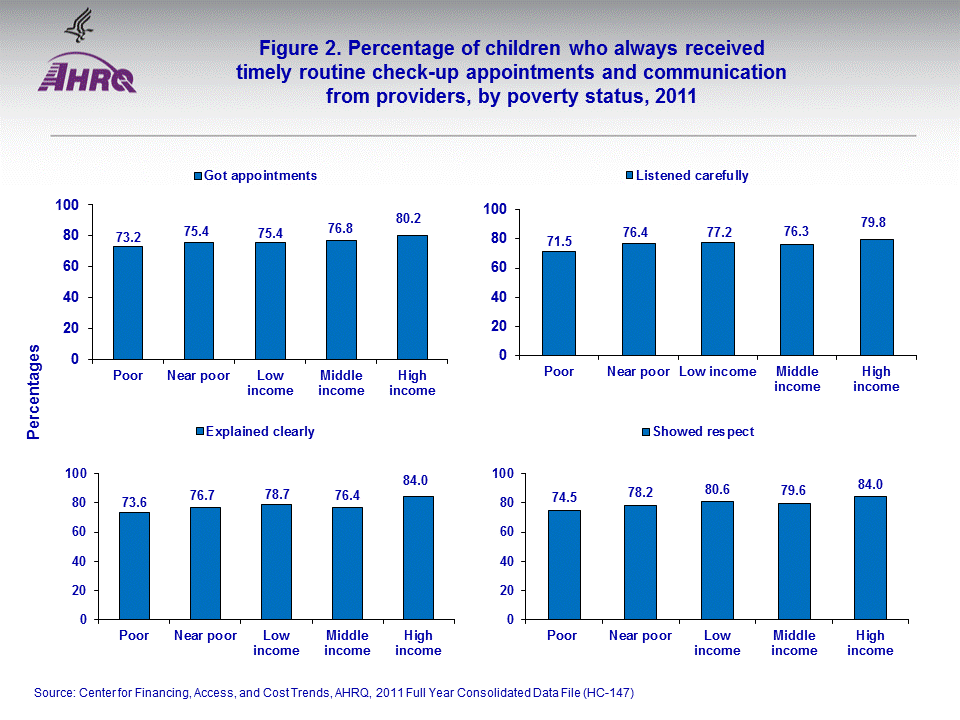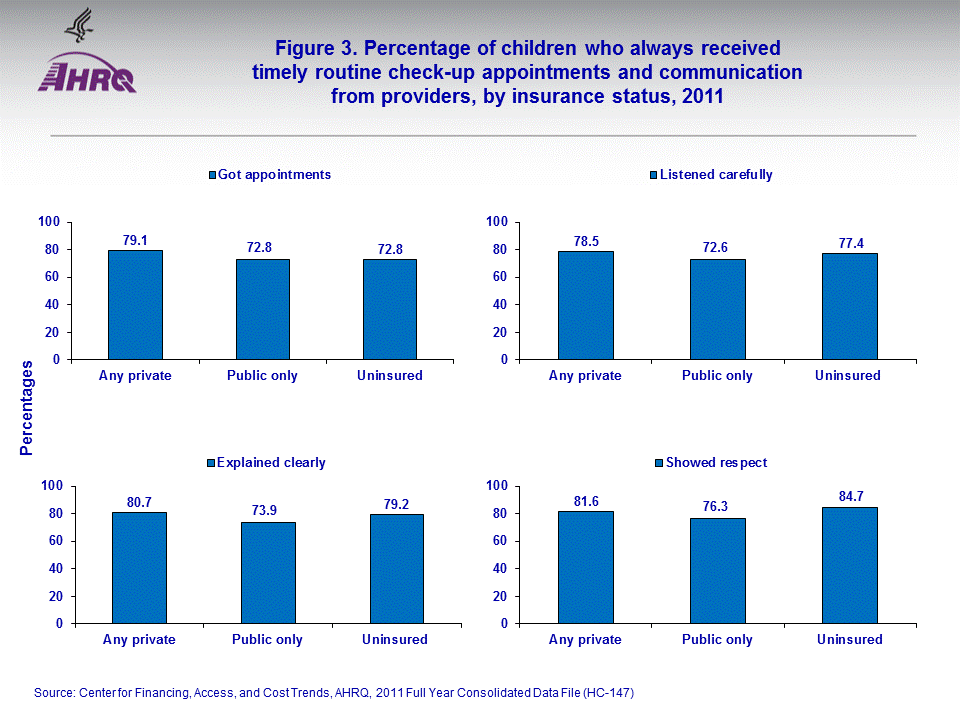
|
|
Font Size:
|
||||
|
|
|
|
||||
STATISTICAL BRIEF #463:
Parents' Experiences in Obtaining Health Care for Children, Ages 0-17, Estimates for the U.S. Civilian Noninstitutionalized Population, 2011
Highlights
- Three-fourths of parents of children from poor families compared to 80 percent from high income families reported always being able to make routine health care appointments for their children as soon as they wanted.
- The parents of 80 percent of children with private insurance as compared to 75 percent with only public insurance reported that their children's doctors always explained themselves clearly during health care visits.
- Parents of Hispanic children were less likely than parents of white non-Hispanic or black non-Hispanic children to be able to make a routine health care appointment for their children when needed.
Introduction
This Statistical Brief provides descriptive statistics from a survey of parents' responses to questions in the Household Component of the Medical Expenditure Panel Survey (MEPS-HC) regarding their experiences while obtaining health care for their children. These particular questions are drawn from the health plan version of CAHPS® (Consumer Assessment of Healthcare Providers and Systems), an AHRQ-sponsored family of survey instruments designed to measure quality of care from the consumer's perspective. The questions examined in this report are only answered by parents of children who had at least one medical visit in 2011. Only differences between estimates that are statistically significant at the 0.05 level are discussed in the text.Findings
In 2011, out of 74 million children in the U.S. civilian noninstitutionalized population, 56.5 million were reported by their parents to have gone to a doctor's office or clinic for care at least once during the year. These appointments included both routine care appointments as well as appointments relating to more urgent health needs. In 2011, 48.9 million children had at least one routine care appointment. The parents of three-fourths (76.7 percent) of those children who had at least one routine care visit reported that they were always able to make an appointment for a routine care health visit for their child as soon as they needed (figure 1). Of children who had had at least one medical visit in 2011, 76.4 percent had parents who reported that the doctor or other health provider always listened carefully to what they had to say. Similarly, parents of 78.3 percent of children reported that the health care provider always explained themselves in a way the parent could easily understand. Parents of 79.8 percent of the children reported that the health providers their children visited showed respect for what the parent had to say.The proportion of children whose parents reported that they were always able to make routine care appointments as soon as needed increased with family income from 73.2 percent of children in poor families to 80.2 percent of children in high-income families (figure 2). Family income also affected the experience of those parents once they arrived at their children's appointment. Only 74.5 percent of poor children had parents who reported feeling that providers always respected what they had to say compared with 84.0 percent for children in high-income families.
White non-Hispanic children (80.7 percent) and black non-Hispanic children (76.5 percent) were more likely to have always gotten routine care appointments when needed than Hispanic children (67.8 percent) (figure 4). Eighty-two percent of parents of white non-Hispanic children and black non-Hispanic children reported always feeling respected by providers, compared with 74.7 percent of Hispanic children.
Data Source
The estimates shown in this Statistical Brief are based on data from the MEPS 2011 Full Year Consolidated Data File (HC-147). The 2011 CAHPS questionnaire for children was fielded during Panel 15 Round 4 and Panel 16 Round 2 of the 2011 Medical Expenditure Panel Survey (MEPS). The CAHPS®, an AHRQ-sponsored family of survey instruments designed to measure quality of care from the consumer's perspective. All of the variables refer to events experienced in the last 12 months and were asked of children ages 0–17.Definitions
Race/EthnicityClassification by race and ethnicity was based on information reported for each family member. Respondents were asked if each family member was Hispanic or Latino. Respondents were also asked which race or races best described each family member. Race categories included white, black/African American, American Indian or Alaska Native, Asian, Native Hawaiian or other Pacific Islander, and other. Based on these questions, sample persons were classified into the following race/ethnicity categories: Hispanic, black non-Hispanic single race, white non-Hispanic single race, and other (Asian non-Hispanic single race, Hawaiian/Pacific Islander non-Hispanic, American Indian/Alaska Native non-Hispanic, and multiple races non-Hispanic).
Age
Age was defined using the last available age (AGELAST) for each sampled person. Children were defined as being those under the age of 18.
Poverty status
Five income groups are defined based on the percentage of the poverty line for total family income, adjusted for family size and composition. These categories were used:
- Poor: Persons in families with incomes less than or equal to the poverty line, including those who reported negative income;
- Near poor: Persons in families with incomes over the poverty line through 125 percent of the poverty line;
- Low income: Persons in families with incomes over 125 percent through 200 percent of the poverty line;
- Middle income: Persons in families with incomes over 200 percent through 400 percent of the poverty line; and
- High income: Persons in families with incomes over 400 percent of the poverty line in the year of the data collection.
Children were classified in the following three insurance categories based on household responses to health insurance status questions:
- Any private health insurance: Individuals, who, at any time during the year, had insurance that provides coverage for hospital and physician care, were classified as having private insurance. Coverage by TRICARE (Armed Forces-related coverage) was also included as private health insurance. Insurance that provides coverage for a single service only, such as dental or vision coverage, was not included.
- Public coverage only: Individuals were considered to have public coverage only if they met both of the following criteria: 1) they were not covered by private insurance at any time during the year; and 2) they were covered by one of the following public programs at any point during the year: Medicare, Medicaid, or other public hospital/physician coverage.
- Uninsured: The uninsured were defined as people not covered by private hospital/physician insurance, Medicare, TRICARE, Medicaid, or other public hospital/physician programs at any time during the entire year or period of eligibility for the survey.
About MEPS-HC
MEPS-HC is a nationally representative longitudinal survey that collects detailed information on health care utilization and expenditures, health insurance, and health status, as well as a wide variety of social, demographic, and economic characteristics for the U.S. civilian noninstitutionalized population. It is cosponsored by the Agency for Healthcare Research and Quality and the National Center for Health Statistics.References
For a detailed description of the MEPS-HC survey design, sample design, and methods used to minimize sources of non-sampling errors, see the following publications:Cohen, J. Design and Methods of the Medical Expenditure Panel Survey Household Component. MEPS Methodology Report No. 1. AHCPR Pub. No. 97-0026. Rockville, MD. Agency for Health Care Policy and Research, 1997. http://meps.ahrq.gov/mepsweb/data_files/publications/mr1/mr1.shtml
Cohen, S. Sample Design of the 1996 Medical Expenditure Panel Survey Household Component. MEPS Methodology Report No. 2. AHCPR Pub. No. 97-0027. Rockville, MD. Agency for Health Care Policy and Research, 1997. http://meps.ahrq.gov/mepsweb/data_files/publications/mr2/mr2.shtml
Cohen, S. Design strategies and innovations in the Medical Expenditure Panel Survey. Medical Care, July 2003: 41(7) Supplement: III-5–III-12.
CAHPS: https://cahps.ahrq.gov/cahps-database/about/index.html
Regular check-ups: http://www.cdc.gov/family/checkup/
Suggested Citation
Soni A., Zibman C. Parents' Experiences in Obtaining Health Care for Children, Ages 0–17, Estimates for the U.S. Civilian Noninstitutionalized Population, 2011. Statistical Brief #463. Agency for Healthcare Research and Quality, Rockville, MD. http://meps.ahrq.gov/mepsweb/data_files/publications/st463/stat463.shtmlAHRQ welcomes questions and comments from readers of this publication who are interested in obtaining more information about access, cost, use, financing, and quality of health care in the United States. We also invite you to tell us how you are using this Statistical Brief and other MEPS data and tools and to share suggestions on how MEPS products might be enhanced to further meet your needs. Please email us at MEPSProjectDirector@ahrq.hhs.gov or send a letter to the address below:
Steven B. Cohen, PhD, Director
Center for Financing, Access, and Cost Trends
Agency for Healthcare Research and Quality
540 Gaither Road
Rockville, MD 20850
 |
||||||||||||||||||||||||||||||||||||
|
||||||||||||||||||||||||||||||||||||
|
|
||||||||||||||||||||||||||||||||||||
 |
||||||||||||||||||||||||||||||||||||
|
||||||||||||||||||||||||||||||||||||
|
|
||||||||||||||||||||||||||||||||||||
 |
||||||||||||||||||||||||||||||||||||
|
||||||||||||||||||||||||||||||||||||
|
|
||||||||||||||||||||||||||||||||||||
 |
||||||||||||||||||||||||||||||||||||
|
||||||||||||||||||||||||||||||||||||
|
|
||||||||||||||||||||||||||||||||||||


